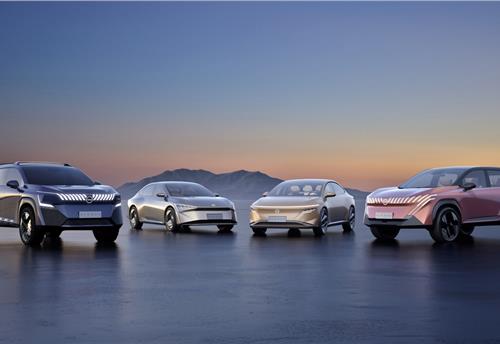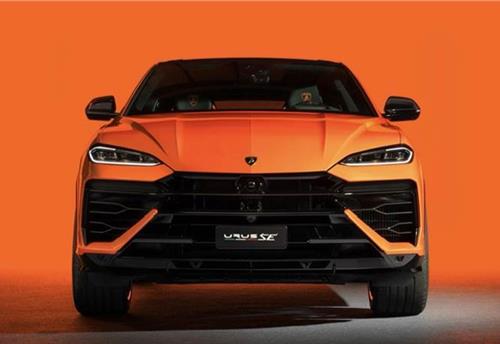Daimler’s new Freightliner Cascadia with Level 2 automated driving premieres at CES
Daimler Trucks is skipping the intermediate step of conditionally automated driving (Level 3) and going to Level 4 that increases efficiency and productivity, and also cuts costs per mile significantly.
At CES 2019, Daimler Trucks has announced that it will invest 500 million euros (around US$ 570 million) over the coming years and create more than 200 new jobs in its global push to bring highly automated trucks (SAE Level 4) to the road within a decade.
The new Freightliner Cascadia offers partially automated driving features (Level 2), making it the first-ever partially automated series production truck on North American roads. It also made its world premiere during yesterday’s presentation of Daimler Trucks at CES.
Highly automated driving is characterised as automated travel in defined areas and between defined hubs without any expectation of the system that a user will respond to a request to intervene. In commercial trucking, Level 4 is the natural next step after Level 2, increasing efficiency and productivity for customers, cutting costs per mile significantly. In doing so, Daimler Trucks is skipping the intermediate step of conditionally automated driving (Level 3). Level 3 automated driving does not offer truck customers a substantial advantage compared to the current situation as there are no corresponding benefits to compensate for the technology costs.
Martin Daum, Member of the Board of Management of Daimler AG with responsibility for Daimler Trucks & Buses, said: “We’ve been pioneering automated trucking. In 2015, our Freightliner Inspiration Truck got the first road license ever for an automated commercial vehicle. Now we take automated trucking to the next level: we’re ready to launch the first partially automated new Freightliner Cascadia in 2019 – and next, we tackle highly automated trucks. Highly automated trucks will improve safety, boost the performance of logistics and offer a great value proposition to our customers – and thus contribute considerably to a sustainable future of transportation.”
Level 2 automated driving in the new Freightliner Cascadia
With Active Drive Assist (Mercedes-Benz Actros, FUSO Super Great) and Detroit Assurance 5.0 with Active Lane Assist (Freightliner new Cascadia), Daimler Trucks is already bringing partially automated driving features into series production.
The new system can independently brake, accelerate and steer. Unlike systems that only work above a certain speed, Active Drive Assist / Detroit Assurance 5.0 make partially automated driving possible in all speed ranges for the driver for the first time in a series production truck. Active lateral control and the connection of longitudinal or lateral control in all speed ranges are new thanks to the fusion of radar and camera information.
Level 4 AD improves safety, efficiency and competitiveness
Highly automated trucks (Level 4) offer enormous advantages in many areas. Level 4 trucks can considerably contribute to that. They enhance safety in traffic thanks to a redundancy of systems and a multitude of sensors and systems that never get tired or lose attention – because today, a great majority of accidents are still due to human error.
Level 4 highly automated trucks also improve efficiency and productivity, among other things, through higher utilisation of the vehicles – practically around the clock. They also make it possible to travel during light traffic times, for example at night, and thus avoid traffic jams by intelligent route management. This has positive effects for truck customers and for the entire economy: the competitiveness of an economy is strongly correlated with the efficiency of logistics. This aspect becomes more and more relevant as global road freight volume is expected to more than double between 2015 and 2050.
Different needs for highly automated driving of cars and trucks
A crucial success factor for the development of a safe and reliable level 4 highly automated truck is a closely coordinated system of engineering and technology development. Daimler Trucks says it uses the extensive knowledge from many years of experience in developing driver assistance systems.
Thanks to its overall portfolio ranging from passenger cars and vans all the way to buses and trucks, the Daimler Group is ideally positioned for all relevant application scenarios of automated driving. Scalable solutions are therefore available.
Developments from the Mercedes-Benz Cars division suitable for haulers and their transport needs will also be used at Daimler Trucks. Level 2 systems now available will be raised to Level 4 through innovation and the re-definition of existing systems.
However, despite all the similarities, the requirements for highly automated driving of cars and trucks differ considerably from one another. The sheer size of a truck makes higher demands on the technology than in the passenger car sector as do moving systems on an articulated system, for example. In addition, the driving behaviour due to a greater mass or other deceleration values as well as other driving characteristics, for example in curves, place much higher demands on the system.
The operating conditions in the transport industry are also much tougher. In order to enable efficient delivery cycles and to meet customer requirements for fast delivery, the vehicles must be operated for as long as possible. This must not lead to any restrictions in durability or reliability, for example under a wide variety of weather conditions and extreme vibrations. Finally, public acceptance is a key factor to successfully integrating Level 4 systems into the value chain.
Two sensors are currently in use at Level 2. In the next development step at Level 4, there will be significantly more, all also higher performing. This leads to a completely new level of data volume but also places extremely high demands on the quality of data processing. The goal: the driver's perception is recreated by the holistic recording of the traffic and vehicle situation by different sensor technologies. With their specific strengths, each sensor makes a contribution to the overall performance and safety. Three different technological approaches form the basis: radar, camera and lidar.
The safety, precision and durability of the systems will already play a leading role at launch. As in aircraft, all safety-relevant functions will therefore be equipped with a redundant system that is capable of seamlessly taking over in case the primary control system malfunctions.
RELATED ARTICLES
Kia displays EV5 and Sonet SUVs for Chinese market
Kia has unveiled a number of key models and new technologies for Chinese customers at the 2024 Beijing International Aut...
Nissan targets growth in China, unveils four NEV concepts at Beijing Motor Show
The two EVs and two plug-in hybrids are a joint effort with Nissan’s local partner Dong Feng and aimed to better address...
Lamborghini unveils Urus SE ahead of Auto China 2024
Electric-only range of 60km helps reduce emissions by 80%.





 By Autocar Pro News Desk
By Autocar Pro News Desk
 08 Jan 2019
08 Jan 2019
 13699 Views
13699 Views









